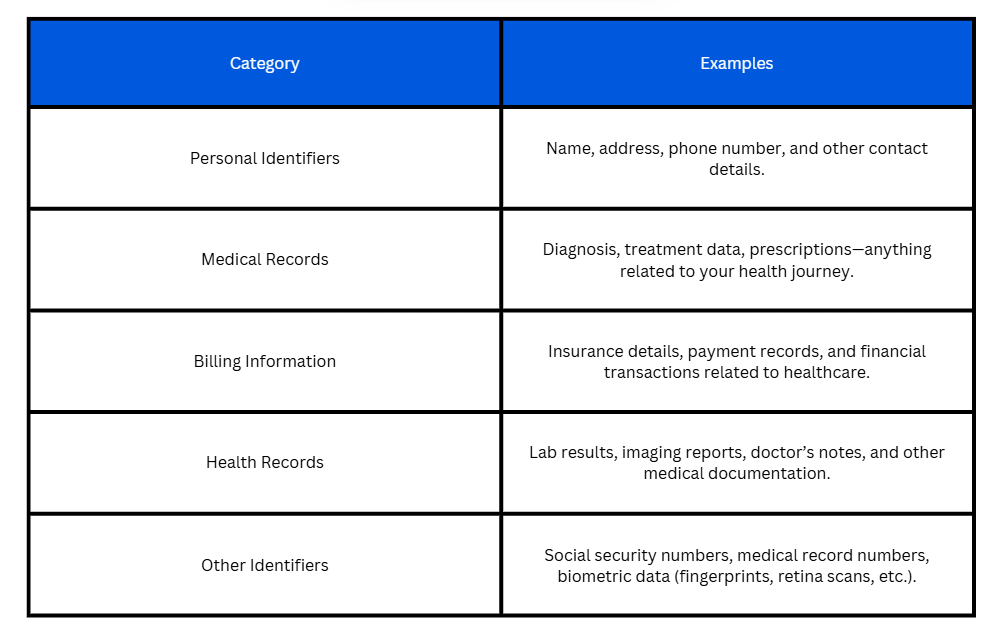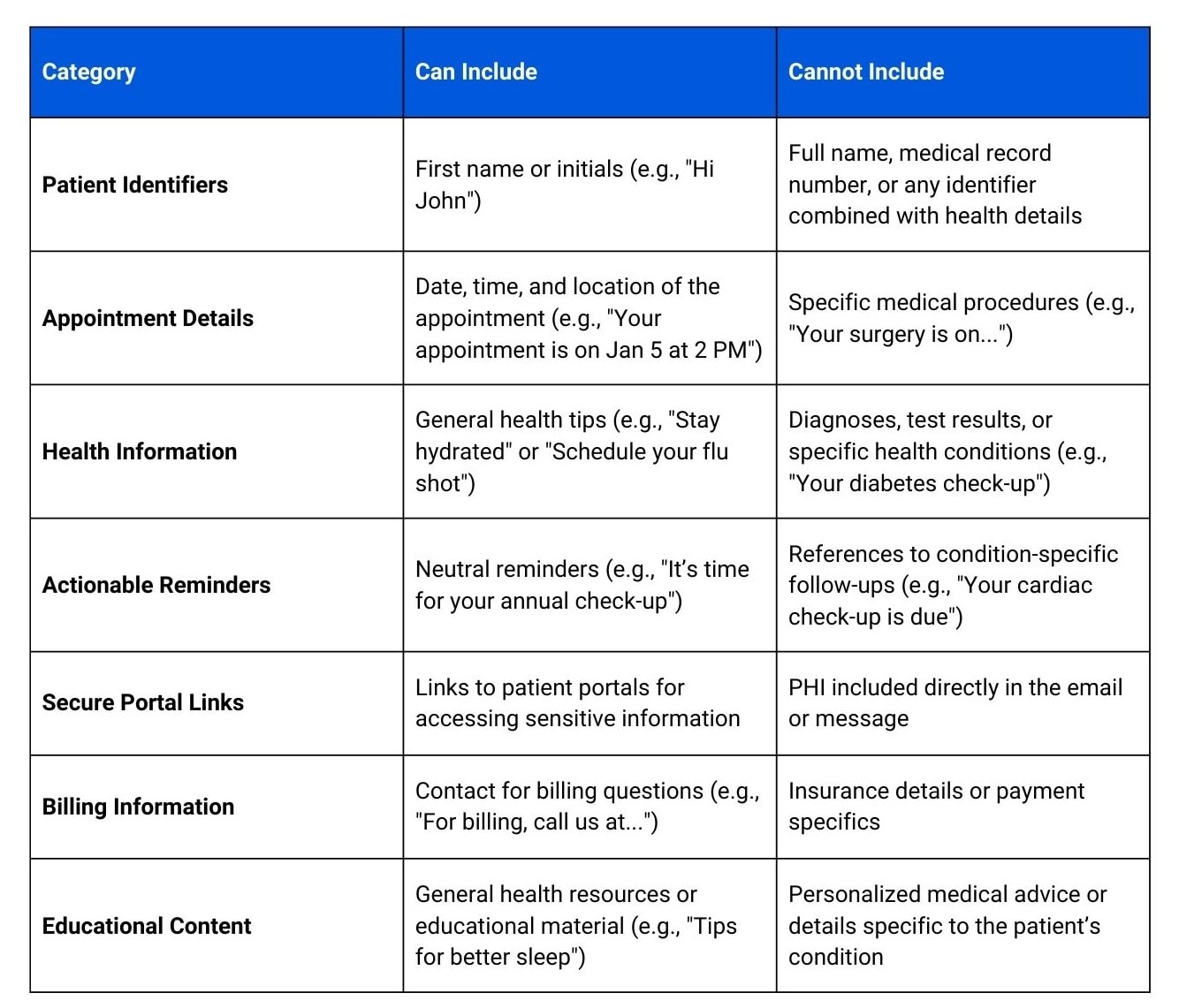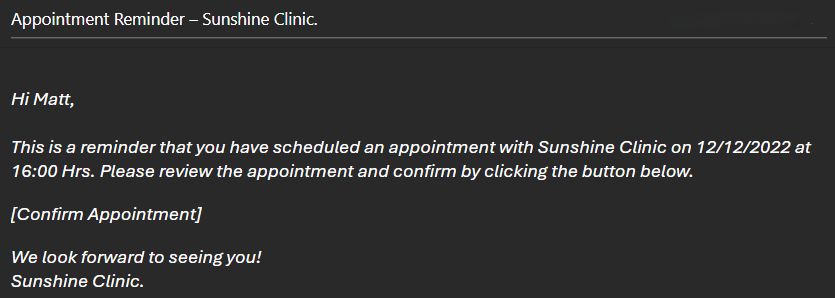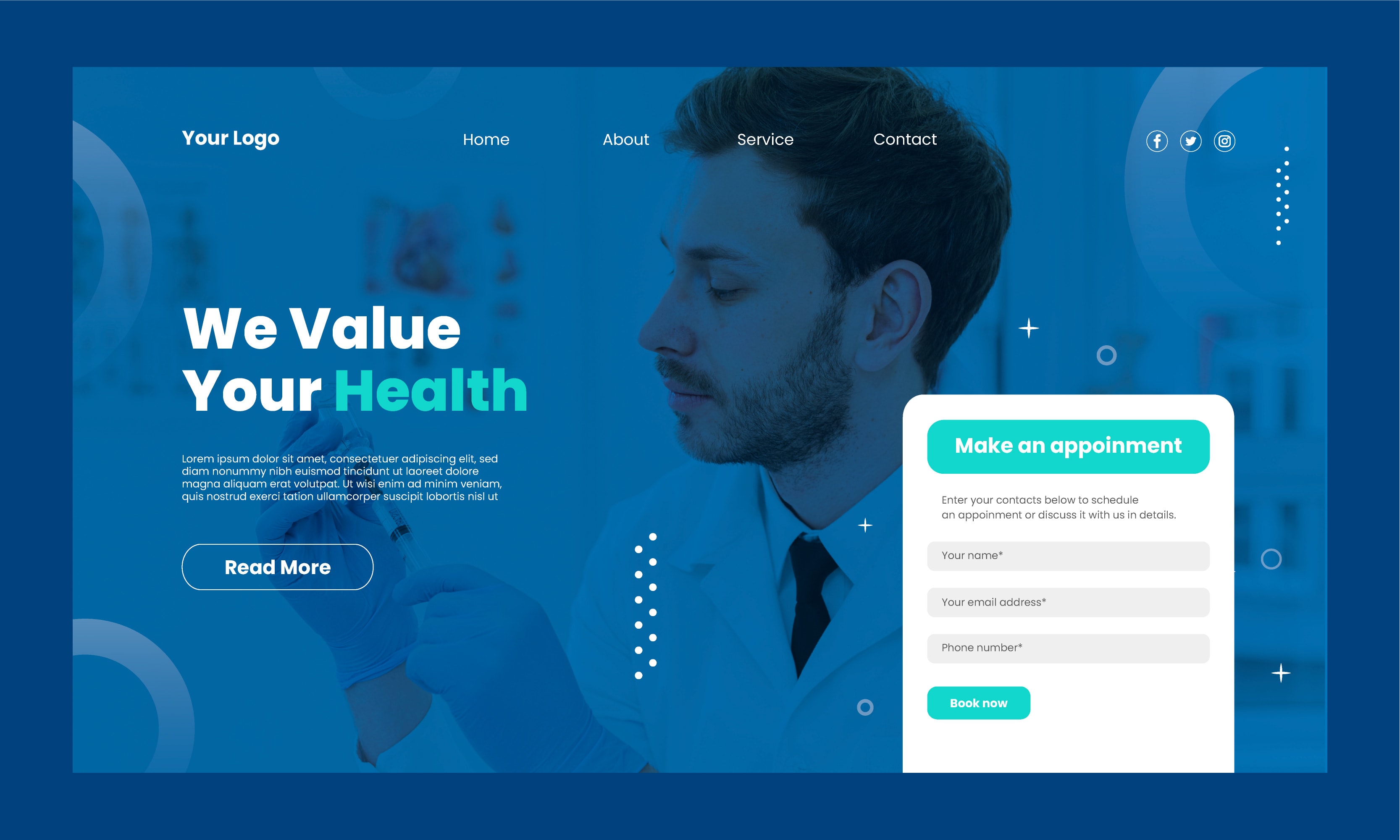Marketing in healthcare is unlike any other industry. A clothing brand can retarget customers with abandoned cart emails. A streaming service can personalize recommendations based on viewing history. But a healthcare provider?
They can’t just email a patient saying, “Hey, noticed you were researching treatments for chronic migraines. Here’s a special offer!”
Why? Because in healthcare, personal data isn’t something you can just toss around. Instead, it’s protected by one of the most stringent privacy laws in the U.S.A. known as HIPAA or Health Insurance Portability and Accountability Act.
And, bound by HIPAA regulations, personal data assumes a new label in the healthcare space – Protected Health Information (PHI).
There’s a reason why it is more tightly secured, unlike other information. Patient data is sensitive and valuable, and without proper safeguards, data breaches happen more often than not.
To give a better picture, here are some statistics on healthcare data breaches that happened in the United States from the year 2009 to 2024:

Although HIPAA’s tentacles encompass the healthcare industry in its totality, today we will focus on the one that extends to the realm of marketing – which we will refer to as HIPAA Compliant marketing.
Every email campaign, ad placement, or patient outreach effort from your side must be HIPAA compliant. One wrong move — an unsecured message, a misused patient detail — and you could face hefty fines, legal battles, and irreversible damage to trust.
So, how can healthcare organizations market the right way without violating HIPAA guidelines?
In this guide, we’ll break down what makes a marketing campaign HIPAA-compliant, the common pitfalls to avoid, and how technology—like healthcare CRMs—can help you navigate these regulations with ease.
Understanding HIPAA Rules for Marketing
Now that we’ve set the stage, let’s dive deep into the complexities of HIPAA-compliant marketing.
Managing Protected Health Information (PHI) within the confines of a hospital or clinic is risky enough — but the stakes are even higher when it comes to HIPAA-compliant marketing. Because unlike internal records or doctor-patient communications, marketing puts information out into the world. And when data moves, so does risk.
[Read more about HIPAA compliance rules here]
What constitutes protected health information?
Any sensitive data that can link a patient to their identity, medical condition, or healthcare treatment is considered Protected Health Information.
Here are different categories of PHI with their examples:

Every outreach effort, whether it’s an email, text, or targeted ad, could potentially involve PHI – as such, healthcare marketers need to be extra careful when dealing with them.
When Does Marketing Require Patient Consent?

If you wish to use PHI in marketing, patient consent is non-negotiable. For instance, using a patient’s treatment history or appointment details to personalize an ad or send a targeted email would cross the line into restricted territory. Here, you must obtain written authorization from the patient, ensuring they fully know how their data will be used. This isn’t just good practice; it’s the law.
Broadly speaking, here’s what you can and can’t do in healthcare marketing to ensure HIPAA compliance.
- Permissible activities include sending general health information or wellness tips to a patient as part of a broader outreach effort, provided it doesn’t reference their specific health information. Think of these as “safe zone” communications—mass communication that serves a broader public health purpose and doesn’t involve individual health details.
- On the other hand, restricted activities include using PHI for promotional efforts — like offering a product or service based on a patient’s medical history or current condition. These types of communications typically require patient consent.
Business Associate Agreements (BAAs) for HIPAA compliance

Now, if your healthcare organization works with third-party vendors to run marketing campaigns (say, healthcare CRMs, email platforms, or ad agencies), HIPAA requires you to have a Business Associate Agreement (BAA) with them. This agreement ensures that third-party vendors are aware of their responsibility to protect sensitive patient information and follow HIPAA regulations.
In essence, a BAA spells out the expectations, protections, and legal responsibilities regarding the handling of PHI. If your vendor doesn’t comply with HIPAA, your organization could be held liable. So, one must vet any external partners and ensure they sign a BAA to avoid any compliance issues down the line.
Challenges in HIPAA-Compliant Marketing
People expect tailored experiences. A patient wants reminders for their upcoming appointment, updates on treatment options, or health tips relevant to their condition. But as we saw, this is not so easy in healthcare. It’s possible, but only if it successfully passes through the restrictive layers of HIPAA regulations.
So, as far as HIPAA-compliant marketing is concerned, striking a balance between relevance and compliance is a challenge that needs to be continually contented with. But there are other challenges as well that healthcare providers will have to confront when it comes to marketing.
Limited use of retargeting & tracking
Imagine searching for mental health services online, only to be bombarded with therapy ads wherever you go. In most other industries, this would be termed tracking and retargeting — that is, showing ads relevant to the person’s internet behavior. But in healthcare, this is nothing but a breach of privacy.
So, HIPAA forbids healthcare practices from tracking visitors and serving them targeted ads, as this could reveal sensitive health information.
Strict advertising regulations
HIPAA strictly prohibits using PHI for ad targeting — not to mention platforms like Google and Facebook have their own layers of restrictions when it comes to healthcare ads.
These platforms also limit personalized healthcare ad targeting, making audience segmentation more difficult. Marketers, instead, must rely on contextual targeting and first-party data instead of behavioral tracking.
Competition & market saturation
The healthcare industry is highly competitive, with hospitals, private clinics, and telehealth providers all competing to grab the attention of patients. So, to stay on top, providers will have to invest in a lot of resources that can drive the results they’re looking for.
Ethical & sensitive messaging
Healthcare marketing must be empathetic and ethical, avoiding fear-based tactics. Here, messages should be crafted in such a way to educate and help rather than pressure patients into making decisions.
HIPAA Compliant Marketing Strategies for Healthcare Organizations

If you think of HIPAA-compliant marketing as a game, then knowing the rules of the game is just the bare minimum. To “win the game,” that is, to get the results you are looking for, you would also need to make sure you master the best strategies and have the best tools at your disposal.
Here’s how you can get started.
Use de-identified data
Unlike PHI, which includes details that can be traced back to an individual (names, contact info, medical records), de-identified data removes or masks those identifiers, ensuring patient anonymity. HIPAA lays out strict methods to ensure that once data is stripped of personal details, it no longer falls under PHI category.
For healthcare marketers, this means, with deidentified data they can analyze trends, segment audiences, and craft targeted campaigns without violating HIPAA regulations.

But that sounds a little too complicated for a human being to do manually.
This is where HIPAA-compliant tools such as healthcare CRMs shine.
How healthcare CRMs help with HIPAA compliant marketing
A HIPAA compliant healthcare CRM, such as LeadSquared, can go a long way when it comes to leveraging patient data for your marketing efforts:
It can help healthcare organizations:
- Group patients based on their data around broader health concerns, like wellness tips or diabetes education, without exposing personally identifiable data.
- Track engagement trends, so they can see what content audience interacts with most.
- Automate outreach based on de-identified patient data. It means their messages can be timely and relevant, but without crossing into privacy violations.
A healthcare CRM doesn’t just ensure that you stay compliant — it’s also faster and spares you the time otherwise spent by your staff doing all this manually.
Coming back to strategies for marketing in healthcare, you will see different mediums and methods adapt to the HIPAA rules differently.
1. Email marketing
Email is one of the most effective ways to engage patients. But even a simple appointment reminder or newsletter can quickly turn into a HIPAA violation if it contains PHI, and isn’t secured.
It is possible to send general emails that do not fall under HIPAA’s restrictions with a regular marketing service.
However, when your communication involves electronic Protected Health Information (ePHI) (which is PHI stored and sent digitally) you would need secure email marketing software, such as LeadSquared’s communication module, to ensure HIPAA compliance.
In any case, here’s what you should know before sending healthcare marketing emails.
- What’s allowed? General wellness tips, educational content, and broad health-related updates that don’t reference specific patients.
- What’s not? Sending unencrypted emails containing diagnoses, treatment details, or any identifiable health data.
Here’s a simple table differentiating what can and cannot be included in HIPAA-compliant email communication

And, here’s an example of a HIPAA compliant email template:

Find more HIPAA-compliant email templates here.
Even if you’re not sharing PHI outright, always ask: If a stranger intercepted this email, could they infer something about the recipient’s identity? If the answer is yes, you’re treading into dangerous territory.
Also, always remember to provide an optout option for people no longer interested in receiving your marketing emails.
2. Text marketing

Texting is quick and convenient, but unlike emails used for healthcare marketing, it doesn’t come with built-in encryption. So healthcare providers must use of HIPAA compliant messaging and telehealth platforms (such as: LeadSquared’s Patient Communication Module, TigerConnect, Zoom for Healthcare) that ensure sensitive communications are encrypted and secure.
Also remember:
- Opt-ins matter: Patients must knowingly agree to receive marketing messages—no assumptions, no pre-checked boxes.
- No PHI in Messages – A simple “Your appointment is confirmed for Tuesday at 10 AM” works, but “Your diabetes checkup is scheduled for Tuesday” crosses the line.
- Secure Alternatives – If PHI must be shared, SMS isn’t generally the place. Instead, direct patients to a secure portal where sensitive details are protected.
The marketing part of healthcare can also intersect with other more general rules and regulations like the Telephone Consumer Protection Act (TCPA), which requires explicit patient consent before sending marketing texts or making promotional calls.
3. Digital advertising
Targeted advertising fuels industries from e-commerce to healthcare. But, as we saw earlier, HIPAA strictly prohibits using PHI for ad targeting.
In other words, digital ads can work in healthcare if they are planned and executed carefully:
- Use general messaging (e.g., “We offer expert dermatology care”) rather than personalized health claims.
- Do not retarget patients based on their medical history or previous website visits.
- Avoid collecting PHI through ad forms unless using HIPAA-compliant tools.
PPC in healthcare marketing
In the world of digital marketing, paid advertising can be a game-changer if you can afford to do it.
PPC (Pay-Per-Click) is a form of paid advertising where healthcare providers pay each time someone clicks on their ad. These ads can appear on search engines (like Google), social media platforms, or other websites, targeting people actively searching for healthcare services or information.
Where PPC excels is in allowing you to reach a highly targeted audience based on their search queries, location, or interests, making it an effective way to drive relevant traffic to your website quickly.
But, different mediums have different restrictions for content that can be advertised.
Here’s an overview of some of the healthcare pay-per-click (PPC) advertising guidelines for Google, Meta (Facebook and Instagram), and LinkedIn:
Google Ads:
- Prescription Drugs: Advertising prescription medications is permitted only in specific regions and requires prior certification from Google. Advertisers must comply with all applicable local laws and regulations.
- Health Insurance: In the U.S., advertisers promoting health and medical insurance coverage must be certified by Google, with exceptions for government entities.
- Restricted Healthcare Content: Certain topics, such as clinical trial recruitment, HIV home tests, addiction services, and prescription drug services, are subject to restrictions. Advertisers should ensure compliance with Google’s healthcare and medicines policy.Sources: support.google.com, transparency.google
Meta (Facebook and Instagram):
- Age Restrictions: Ads promoting dietary supplements, weight loss products, and cosmetic procedures must target users aged 18 and older.
- Prescription Drugs: Promoting prescription drugs is allowed but cannot target individuals under 18. Advertisers must obtain prior authorization from Meta.
- Data Privacy Updates: Starting January 2025, Meta will restrict health and wellness brands from using key event tracking like “Purchase” or “Add to Cart” for ads. Businesses must shift to non-restricted events such as “Landing Page Views” or “Engagement” for campaign optimization. Sources: transparency.meta.com, digitalposition.com
LinkedIn:
- Healthcare Advertising: LinkedIn permits healthcare-related ads but requires adherence to all applicable laws and regulations. Pharmacy and telehealth ads are restricted, require prior authorization, and are limited to the U.S., with no targeting of minors. Medical device and treatment ads must comply with legal regulations and can only be promoted where permitted, also excluding minors from targeting.
Source: LinkedIn advertising policies
Why PPC works in Healthcare:
- Instant visibility: Ads can immediately put your healthcare services in front of people who are actively searching for them.
- Precise targeting: You can focus on specific keywords, locations, or even demographics (like age or gender) to ensure your ads reach the right audience.
- Measurable results: PPC campaigns provide detailed data on clicks, conversions, and ROI, allowing for optimization and better budget allocation.
4. Social media

Social media is the best place for brands to build trust, share knowledge, and create communities. But here is what healthcare organizations need to be wary of when using this medium:
- Patient stories? Get written consent. Even anonymized testimonials can reveal identities if details are too specific.
- Avoid direct engagement on health matters. Answering general questions is fine, but offering medical advice involving PHI in a public comment thread is not.
- Remember: The internet never forgets. Once something is posted, it’s nearly impossible to erase, making careful content planning essential.
5. Content marketing

Content is one of the safest ways to engage audiences without crossing HIPAA’s safety lines. No intrusive ads. No risky data handling. Just valuable information that educates, builds trust, and positions your organization as a credible source.
Provided you are leaving PHI out of it, here is what you can do with content marketing.
Educational content
Patients today don’t just rely on doctors for medical advice—they Google everything and follow trends on social platforms. From symptoms to treatment options to wellness tips, the internet is their first stop. So, this is where your content can make a difference.

But in order for it to rank higher in the search results and reach more people, your content must be optimized for the search engine.
SEO (Search Engine Optimization) can help you do this by focusing on improving your website’s organic ranking in search results, like showing up on the first page when someone searches for “mental health tips” or “chiropractic services.”
While it takes time, SEO helps you build long-term, sustainable traffic.
How PPC and SEO Work Together in Healthcare:
- Data from PPC campaigns can inform your SEO strategy, helping you target the most effective keywords.
- You can use PPC to drive immediate traffic while SEO will build long-term organic growth for you.
Here are the types of content that you can optimize for search engines:
- Blog posts breaking down complex healthcare topics into easy-to-understand insights.
- Infographics & videos explaining conditions, treatments, or general health tips.
- E-books & guides that provide in-depth knowledge without referencing individual patients.
Patient stories
Success stories and testimonials can be incredibly persuasive, but even if patients’ names are omitted, too many specifics can make a case identifiable and violate HIPAA regulations.
Still, you can do it, if you:
- Get written consent—not just verbal permission. A signed HIPAA authorization form is a must.
- Use generalized, anonymized stories—“Many patients find relief with X treatment” instead of “One patient who struggled with Y saw success.”
- Focus on the healthcare provider’s perspective—highlight best practices, not personal details.
6. Website & lead capture forms

Landing pages are a powerful tool for healthcare marketing. They allow you to capture leads, offer resources, and guide potential patients toward taking action.
Since they interact with patients online and collect their info, healthcare practitioners need to ensure that all data is handled securely.
These HIPAA-compliant landing pages need to be designed with user experience in mind, too. No one wishes to be overwhelmed with lengthy forms or a barrage of disclaimers. The best pages collect just enough information to provide value to both the patient and the provider—without going overboard.
But if you want total freedom when building the landing page of your choice then LeadSquared CRM’s versatile landing page feature is exactly what you are looking for.
Uses of HIPAA- compliant websites & landing pages
- Patient Portals: These are secure areas where patients can log in to view their medical records, communicate with healthcare providers, request prescriptions, or schedule appointments. To protect the privacy of their information, these portals must be HIPAA-compliant.
- Contact Forms: When patients reach out through contact forms to ask about their health, schedule appointments, or share medical information, those forms must be encrypted and protected to prevent any unauthorized access to sensitive data.
- Appointment Scheduling: If a website allows patients to book appointments, it must ensure that any personal information entered (like health details or appointment preferences) is protected in compliance with HIPAA.
- Online Payments: Healthcare websites often handle payments for services, and payment gateways must be HIPAA-compliant when collecting billing information, ensuring the data is encrypted and safely processed.
- Lead Generation: Many healthcare organizations use landing pages to capture leads (potential patients or clients). If these forms ask for sensitive health information, HIPAA compliance is essential to protect that data and avoid breaches.
- Marketing: Healthcare organizations might use HIPAA-compliant landing pages for targeted marketing efforts, offering services like consultations or educational materials. These landing pages must be designed to ensure no PHI is improperly collected or shared.
- Telehealth: With the rise of telemedicine, HIPAA-compliant websites and landing pages are essential for online consultations, ensuring that video calls, patient records, and any data exchanged are securely handled and compliant.
SSL certificates and landing pages:
- SSL certificates (Secure Sockets Layer) encrypt data transmitted between the user and the website, ensuring that any sensitive information, like patient details, is secure from unauthorized access.
- When visitors land on a page with an SSL certificate, the URL starts with “https://”, indicating that the connection is encrypted.
- Without SSL encryption, any information submitted through forms (such as personal health information) on your landing page could be intercepted, violating privacy regulations like HIPAA.
- Data encryption ensures that Protected Health Information (PHI) is not readable by unauthorized parties.
- For healthcare landing pages, any collected information (like patient names, email addresses, appointment details, etc.) must be encrypted both during transmission and storage.
- HIPAA requires healthcare providers to implement strict security measures to protect PHI, including using encrypted forms and secure communication methods when collecting data through landing pages.
Best Practices for Implementing HIPAA-Compliant Marketing
Conducting risk assessments before launching campaigns
Imagine you’re about to send a highly targeted email or SMS blast. Before the “send” button is even a thought, a risk assessment should be your first step. This is where you identify potential vulnerabilities in your marketing processes — from how you store patient data to how you share it across platforms. Doing so ensures you’re not inadvertently putting patient privacy at risk, which could come back to bite you in the form of a hefty fine or lost trust.
Training marketing teams on HIPAA regulations
HIPAA regulations can be tricky, and even experienced marketers slip up if they’re not properly educated. Regular training is key — it’s not enough to just assume everyone is on the same page. Every team member, from the email marketer to the social media manager, must understand the boundaries of HIPAA-compliant marketing and be able to spot potential pitfalls before they turn into violations. It’s better to over-educate than to be blindsided by a misstep.
Using secure marketing tools & platforms
The tools you use to run your marketing campaigns matter. Whether it’s a CRM system or an email platform, these marketing tools should be equipped with robust security features, such as end-to-end encryption. If your platforms aren’t built with HIPAA in mind, you’re setting yourself up for failure.
A healthcare CRM, for example, ensures that every patient detail is securely stored and only shared with authorized users, providing that peace of mind while keeping your campaigns running smoothly.
Ensuring ongoing compliance monitoring with audits
As healthcare marketing grows more complex and new platforms emerge, it’s important to regularly audit your campaigns and practices. This means checking that your email lists are up-to-date, confirming that consent was properly obtained, and ensuring any third-party vendors are still operating within the legal boundaries.
Regular audits are your best defense against unforeseen violations and ensure that your marketing remains HIPAA-compliant as you evolve.
Conclusion
Marketing in healthcare has its fair share of challenges, and ensuring HIPAA compliance is one of the most critical. From securing patient data in email campaigns to using compliant landing pages and advertising strategies, every touchpoint must prioritize privacy and security.
By implementing the right tools and practices — such as encrypted communication channels, HIPAA-compliant CRMs, and privacy-conscious marketing strategies—healthcare organizations can engage with patients effectively while staying within regulatory boundaries.
This is where LeadSquared can help. Our HIPAA-compliant CRM and marketing automation solutions enable secure lead management, patient outreach, and engagement tracking and more — all while ensuring that your sensitive patient data remains protected.
Get in touch with our team to know more!
FAQs
HIPAA-compliant marketing simply means promoting your healthcare services while protecting patient information. Since HIPAA (Health Insurance Portability and Accountability Act) is all about patient privacy, any marketing effort that involves patient data—like email campaigns, retargeting, or even testimonials—must follow strict guidelines to avoid violations. It matters because non-compliance can lead to hefty fines, legal trouble, and loss of patient trust.
Yes, but only with explicit written consent from the patient. HIPAA’s Privacy Rule restricts the use of Protected Health Information (PHI) for marketing unless the patient knowingly agrees to it. That means you cannot use patient emails, phone numbers, or health history for promotions unless they have opted in. Even then, you must securely store and transmit this data.
Several common marketing mistakes can lead to HIPAA violations, such as:
1. Sending healthcare emails using unsecured email platforms instead of HIPAA-compliant ones.
2. Using patient information (like names, conditions, or appointment details) in ads without patient consent.
3. Retargeting patients with online ads based on their medical history.
4. Sharing PHI with third-party marketing agencies without a Business Associate Agreement (BAA).
A BAA is a legal contract that healthcare organizations must have with third-party vendors (like marketing agencies, CRM providers, or email services) that handle PHI on their behalf. It ensures these vendors comply with HIPAA rules and properly secure patient data.
If you’re outsourcing email campaigns, SMS marketing, or any patient-related marketing activity, you must have a BAA in place with the service provider.
Yes, but with caution. Google and Facebook don’t guarantee HIPAA compliance, so you can’t use PHI (like patient lists) for retargeting. However, you can run general awareness campaigns about your services, as long as they don’t disclose patient data.
A safer option? Use contextual targeting (based on interests or search behavior) instead of patient data to reach the right audience.
Yes, but you need to follow these rules:
1. Obtain explicit patient consent before sending marketing emails or texts.
2. Use HIPAA-compliant platforms (like LeadSquared) instead of standard email services.
3. Encrypt sensitive data to protect PHI from unauthorized access.
4. Allow opt-outs in every message, so patients can unsubscribe easily.
Marketing is allowed, but security and consent are non-negotiable.
You can. But you must have written authorization from the patient before using their testimonial, photo, or video. Even if they post a review online, you can’t share it on your website or social media without their permission.
Get written consent upfront and clearly explain how their information will be used.
Your website should do more than just look good—it must also protect patient data. Here’s how:
1. Use HTTPS encryption to secure form submissions.
2. Ensure contact forms and chatbots are HIPAA-compliant.
3. Avoid storing PHI on your website’s backend (use secure, third-party storage instead).
4. Update your privacy policy to explain how patient information is handled.
Yes, but you need to be careful. If your agency will handle any patient data — like email lists, appointment information, or campaign analytics tied to individuals — you must sign a Business Associate Agreement (BAA) with them. This legally binds them to follow HIPAA regulations.
The fine for violations can range from $141 to $70,000 based on the severity or more than $2 million depending on the scale. If you realize you’ve made an error, take these steps:
1. Report it immediately to your compliance officer or legal team.
2. Contain the issue (e.g., delete the exposed data, stop unauthorized campaigns).
3. Notify affected parties if PHI was compromised.
4. Strengthen security and train your team to prevent future mistakes.
Proactive compliance is always better than damage control—so stay ahead of the risks!









